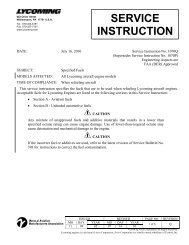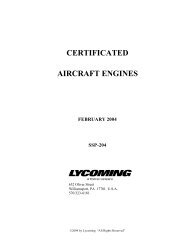Create successful ePaper yourself
Turn your PDF publications into a flip-book with our unique Google optimized e-Paper software.
7. Automotive fuel used in an aircraft engine may lead to destructive<br />
detonation or preignition and potential engine failure at high<br />
power conditions.<br />
8. Please review the Mo-Gas fuel requirements in your state or<br />
destination.<br />
SUMMARY:<br />
Auto fuel is now being used as a substitute for Grade 80 aviation<br />
gasoline under STCs issued by the FAA. Most major oil companies<br />
and engine manufacturers continue to recommend that<br />
aircraft piston engines be operated only on aviation gasoline.<br />
Deterioration of engine and fuel system parts have been reported<br />
in aircraft using auto fuel. Operators should consider the added risk<br />
of using auto fuel in aircraft. Remember — a pilot can’t pull over<br />
to the side of the road when fuel creates a problem with the engine.<br />
The advent of the lightweight turbocharger has been called the<br />
shot of adrenaline which the piston engine needed to remain the<br />
prime method of powering general aviation-type aircraft. Although<br />
in some respects this may be an overstatement, it does have much<br />
merit, and it is the lightweight turbocharger that has enabled<br />
general aviation aircraft to operate above adverse weather in the<br />
smooth air of the higher altitudes, and to realize that increased true<br />
air speed is not possible with normally aspirated engines. So this<br />
is the “why” of turbocharging, and since it is possible that there<br />
is a turbocharged <strong>Lycoming</strong> engine in your present or future, we<br />
are going to review the very basics of turbocharging and bring the<br />
reader up to the present “state of the art” of it.<br />
The aircraft engine, as any reciprocating engine, is a heat engine<br />
which derives its power from the burning of a mixture of air<br />
and fuel, which has been mixed in the proper proportions by a<br />
fuel-metering device. The amount of power the engine develops<br />
will be directly proportional to the total mass of air pumped<br />
through the engine, providing the fuel/air ratio is kept constant.<br />
This can be varied in a normally aspirated (unturbocharged)<br />
engine by changing the throttle setting and/or changing the RPM.<br />
Let us go over that again. Changing the throttle will vary the manifold<br />
pressure available to the cylinder during the intake stroke.<br />
As a result, the cylinder will develop a given amount of power<br />
on each power stroke. So if we increase manifold pressure to the<br />
cylinder, we will in turn receive more power from the engine.<br />
Now if we keep the manifold pressure constant, but increase the<br />
number of power strokes by increasing the RPM, we will also<br />
receive more power from the engine. We see that changing either<br />
the throttle setting (manifold pressure) or the number of power<br />
strokes per minute (RPM), will result in varying the total air mass<br />
flow through the engine and will determine the horsepower the<br />
engine will develop. So in essence, a reciprocating engine is also<br />
an air pump, and if the fuel/air ratio is kept constant, the power<br />
developed will vary directly with the mass of air consumed.<br />
We are limited in the speed at which we can operate the engine<br />
because of engine and prop mechanical limitations. So the only<br />
8 L y c o m i n g F l y e r<br />
other way to change the mass flow is to increase the manifold<br />
pressure. We all know, however, that as we ascend in altitude, the<br />
air becomes less dense which reduces the mass flow through the<br />
engine with the result of a power loss that is proportional to the<br />
reduced-mass air flow through the engine. You have noted that<br />
in climb with a normally aspirated engine, it is necessary to keep<br />
opening the throttle if you are to keep the air speed and the rate<br />
of climb constant. So we see that if there were a way we could<br />
put the engine into a container so it could be kept at sea level<br />
conditions, we could maintain the same performance regardless<br />
of ambient conditions and altitude.<br />
A long time ago, a smart engineer who was thinking along these<br />
same lines reasoned that if he built an air pump into the engine that<br />
could pump the less dense air at altitude up to the same pressure<br />
he had at sea level, he would be able to maintain sea level horsepower.<br />
So he designed a centrifugal air compressor and placed it<br />
between the fuel-metering system and the intake pipes. The pump<br />
consisted of an impeller, diffuser and collector. The impeller was<br />
driven at about 12 times crankshaft speed, and this high rotational<br />
speed imparted a large velocity of energy to the air passing<br />
through. Now as the fuel/air charge leaves the impeller, it goes to<br />
the diffuser where vanes smooth out the air flow while allowing<br />
the mixture to slow down so that the velocity pressure acquired<br />
from the rapid rotational speed of the impeller is transformed<br />
into static pressure. This air mass is then stored momentarily and<br />
equalized in the collector and is then drawn into the cylinders. Our<br />
engineer now has his air pump, but how is he to drive it? Well,<br />
he could drive it from the accessory gear train or from the rear<br />
of the crankshaft, but both of these methods robbed the engine<br />
of horsepower it could deliver to the propeller. Although superchargers<br />
for many years have been driven mechanically off the<br />
crankshaft, our engineer realized he had not reached the ultimate<br />
in the “state of the art” of supercharging, so he began looking for<br />
another means of driving his air pump.<br />
Our hypothetical engineer realized that the largest percent of<br />
energy released by burning the fuel/air mixture was going out<br />
of the exhaust pipe in the form of heat. Realizing if he could in<br />
some way harness this wasted energy to drive his air pump, the<br />
horsepower normally robbed from the engine to drive the impeller<br />
could be used by the propeller.<br />
We have all seen a windmill turning in the breeze, so our engineer<br />
rightfully reasoned if he put a turbine wheel in the exhaust stream,<br />
he could take the hot exhaust gas under pressure and expand<br />
it as it passed through the wheel to extract energy. He took an<br />
impeller, connected it by a common shaft to the turbine, and he<br />
had a means of driving his air pump by energy which was formerly<br />
going to waste. Supercharging by means of using exhaust<br />
gases to drive the air pump is called turbocharging. Now our<br />
engineer had progressed to the point where he required a means<br />
of controlling his turbocharger. As he climbed in altitude the<br />
pump must constantly put out a higher pressure ratio in order to<br />
maintain sea level conditions. He reasoned that if he can dump<br />
the exhaust gas at sea level through a butterfly valve in a leg off<br />
the exhaust pipe and ahead of the turbine wheel, he will be able<br />
to control the amount of energy being used to drive the turbine<br />
and thus control the speed of the compressor.







